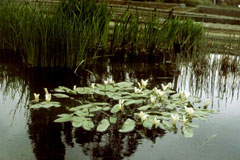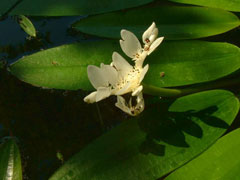 |
|
(c) 2010 Ken Fern & Plants For A Future |
 |
| http://commons.wikimedia.org/wiki/User:Jeffdelonge |
Translate this page:
Summary
Physical Characteristics
![]()
![]() Aponogeton distachyos is a PERENNIAL.
Aponogeton distachyos is a PERENNIAL.
See above for USDA hardiness. It is hardy to UK zone 9 and is not frost tender. It is in flower from April to October. The species is hermaphrodite (has both male and female organs).
Suitable for: light (sandy), medium (loamy) and heavy (clay) soils. Suitable pH: mildly acid, neutral and basic (mildly alkaline) soils. It cannot grow in the shade. It prefers wet soil and can grow in water.
UK Hardiness Map
US Hardiness Map
Synonyms
Plant Habitats
Pond; Bog Garden;
Edible Uses
Edible Parts: Flowers Root Shoots Stem
Edible Uses:
Tuber - roasted[17, 105]. Starchy[183]. Considered to be a great delicacy[2]. Flowering spike - pickled or used as a spinach or asparagus substitute[2, 17, 46, 166, 142, 177, 183]. The young shoots are used as an asparagus substitute[142, 177]. The flowers are used as a flavouring[56].
References More on Edible Uses
Medicinal Uses
Plants For A Future can not take any responsibility for any adverse effects from the use of plants. Always seek advice from a professional before using a plant medicinally.
None known
References More on Medicinal Uses
The Bookshop: Edible Plant Books
Our Latest books on Perennial Plants For Food Forests and Permaculture Gardens in paperback or digital formats.

Edible Tropical Plants
Food Forest Plants for Hotter Conditions: 250+ Plants For Tropical Food Forests & Permaculture Gardens.
More

Edible Temperate Plants
Plants for Your Food Forest: 500 Plants for Temperate Food Forests & Permaculture Gardens.
More

More Books
PFAF have eight books available in paperback and digital formats. Browse the shop for more information.
Shop Now
Other Uses
References More on Other Uses
Cultivation details
A water plant, growing in water 15 - 60cm deep. it can also grow in wet soil but is then very restricted[56]. It requires a rich soil[56]. The tubers are not winter hardy[56]. Another report says that the plants are hardy in the milder areas of Britain[166]. They have withstood a fairly severe winter in Cornwall, when the ponds had thick ice 30cm or more deep, with very little damage[K]. A very ornamental plant[1], the flowers have a hawthorn-like scent[245].
References Carbon Farming Information and Carbon Sequestration Information
Temperature Converter
Type a value in the Celsius field to convert the value to Fahrenheit:
Fahrenheit:
The PFAF Bookshop
Plants For A Future have a number of books available in paperback and digital form. Book titles include Edible Plants, Edible Perennials, Edible Trees,Edible Shrubs, Woodland Gardening, and Temperate Food Forest Plants. Our new book is Food Forest Plants For Hotter Conditions (Tropical and Sub-Tropical).
Shop Now
Plant Propagation
Seed - best sown in a pot as soon as it is ripe and kept emmersed in 3cm of water. The seed can also be stored in water and sown in spring[134]. It usually germinates in 1 - 2 months at 20°c[134]. When large enough to handle, prick the seedlings out into individual pots and grow them on in just covered in water in a greenhouse for their first winter. Plant them out in late spring or early summer, after the last expected frosts. Division can be carried out at any time in the growing season, though mid to late spring is probably best. The divisions can be planted straight out into their permanent positions.
Other Names
If available other names are mentioned here
Aponogeton distachyos or Aponogeton distachyum, also known as waterblommetjie (lit. trans. water-floret), Cape-pondweed, water hawthorn, vleikos and Cape pond weed
Native Range
AFRICA: South Africa (Western Cape)
Weed Potential
Right plant wrong place. We are currently updating this section.
Please note that a plant may be invasive in one area but may not in your area so it's worth checking.
Conservation Status
IUCN Red List of Threatened Plants Status :

Growth: S = slow M = medium F = fast. Soil: L = light (sandy) M = medium H = heavy (clay). pH: A = acid N = neutral B = basic (alkaline). Shade: F = full shade S = semi-shade N = no shade. Moisture: D = dry M = Moist We = wet Wa = water.
Now available:
Food Forest Plants for Mediterranean Conditions
350+ Perennial Plants For Mediterranean and Drier Food Forests and Permaculture Gardens.
[Paperback and eBook]
This is the third in Plants For A Future's series of plant guides for food forests tailored to
specific climate zones. Following volumes on temperate and tropical ecosystems, this book focuses
on species suited to Mediterranean conditions—regions with hot, dry summers and cool, wet winters,
often facing the added challenge of climate change.
Read More
Expert comment
Author
L.f.
Botanical References
200
Links / References
For a list of references used on this page please go here
Readers comment